
Today’s post is by book advertising consultant Matt Holmes (@MatthewJHolmes1).
From April 2020 through to November 2022, I ran Facebook Ads in a way that ticked all the boxes when it came to best practices. But in December 2022, our Facebook Ads took a nose dive—sales, page reads, bestseller rank, and overall royalties all dropped. We went from earning $17,396 in November 2022, to less than $10,000 in January 2023. That’s a big drop in 2 months.
Something had to change. I tested everything—new audiences, new ad creative, higher daily budgets, different ad placements—but nothing worked. Until that is, at the end of January 2023, I had one last push testing something I’d never tested before. I 100% believed this wasn’t going to work and was incredibly skeptical. But what did I have to lose?
Nothing else has worked, but boy did this new strategy work. It tripled our Facebook Ads conversion rates in the UK, and doubled our Facebook Ads conversion rates in the USA, in comparison to the results I’d been having from Facebook Ads since April 2020.
And this new Facebook Ads strategy I discovered is what I’m going to share with you today, that is responsible for the $17,500 month we had in July 2023, with my wife’s 4 fantasy novels (4 books in the main series, plus 1 companion novel).
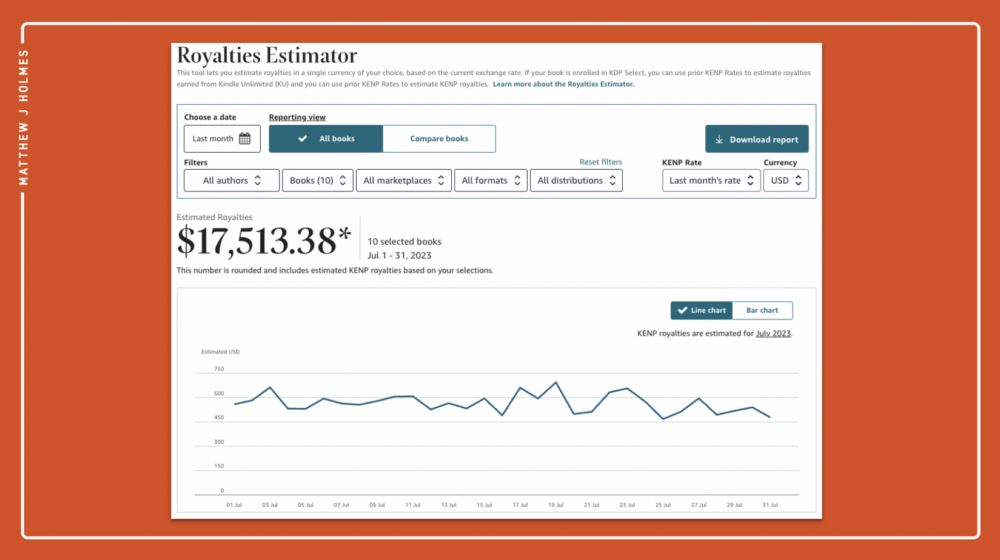
Here’s what you’ll learn in this article:
- Why the traditional method of running Facebook Ads is outdated (and is in fact hurting your results, and your bottom line)
- My exact Facebook Ads strategy (that shouldn’t work, but does)
- The biggest lever you can (and should) pull when advertising books with Facebook Ads
- How I test Facebook Ads that harness the power of Facebook’s machine learning
- Why less is more when it comes to optimizing and scaling your Facebook Ads for bigger and better results
The problems with following Facebook Ads best practices
If you are a member of one or two Facebook Groups discussing Facebook Ads for authors, you have likely come across best practice strategies. Invariably, these discussions revolve around targeting, specifically using something known as Detailed Targeting with your Facebook Ads. On the surface, Detailed Targeting sounds incredibly exciting, but in practice, it’s destroying your results.
Detailed Targeting allows you, as the advertiser, to pinpoint who you want to show your Facebook Ads to, for example:
Women, in the USA, aged 25–60, who have an interest in Stephen King, Amazon Kindle, and the Kindle Store
What could possibly go wrong? After all, these are your ideal readers who are going to love your book!
Well, there are a few things that could and most likely, will, go wrong with Detailed Targeting:
- The performance of your Ads is going to get worse and worse over time
- You’re restricting the Facebook Ads algorithm from performing at its best
- The Detailed Targeting audience you choose could be removed at any time (without warning)
- You will pay more to use Detailed Targeting audiences
- Performance will be volatile
- It will be difficult to scale Ads (i.e. spend more) that use Detailed Targeting
- Many people who are in a Detailed Targeting audience don’t actually belong there
To top it off, your Ads aren’t even reaching the people who would most likely resonate with your book(s). This is because you are throttling the algorithm too much to be able to do the job it was designed and engineered to do in the first place.
In essence, when you use Detailed Targeting, you are investing in a depreciating asset, that will only become worse and worse over time. How do I know this? Because I used to use Detailed Targeting myself, and I’ve seen all of the scenarios above play out with my own Facebook Ads.
So, if Detailed Targeting is so bad, what do I use? I use a strategy I call Unrestricted Targeting, which we’ll dive into right now.
Here’s my Exact Facebook Ads strategy
If you want to see your Facebook Ads performance skyrocket, you need to use this incredibly powerful tool as it was designed to be used.
You see, what many advertisers don’t realize is that the Facebook Ads you run (i.e. the ads people see on their Facebook feed) create their own audiences, based on the content of those ads. As soon as you publish an ad, the Facebook Ads algorithm is going to analyze that ad and look at elements such as:
- The words you use in your ad
- The style of image in your ad
- The content of your image (e.g. gender of person, emotions, age, landscape, object, etc.)
- It’s even going to look at the landing page you’re sending people to from your ad
- And many more data points besides
Based on the data the algorithm collects from its analysis, it’s going to start building an audience of people it believes will resonate with this specific ad, and start showing it to those people. As it learns which of these people do and don’t like the ad, it will find more people who have similar characteristics to people that did like the ad, and stop showing it to people who have similar characteristics to those who didn’t like the ad.
And over time, the performance of the ads just becomes better and better, as the algorithm starts learning who does and doesn’t like the ad. You can see from the diagram below just how much restriction you are placing on the algorithm when you follow best practice and use Detailed Targeting with your Facebook Ads.

With this in mind, as I alluded to a little earlier, I want to give the Facebook Ads algorithm free rein to find the ideal audience for my ads, and I achieve this through Unrestricted Targeting.
With Unrestricted Targeting, the only targeting I’m using is:
- Location
- Gender
- Age
I am using zero Detailed Targeting—yes, I’m going against all the best practice advice out there for authors, and have been doing so since the beginning of 2023.
You can see my targeting setup illustrated in the screenshot below of one of my Facebook Ads:
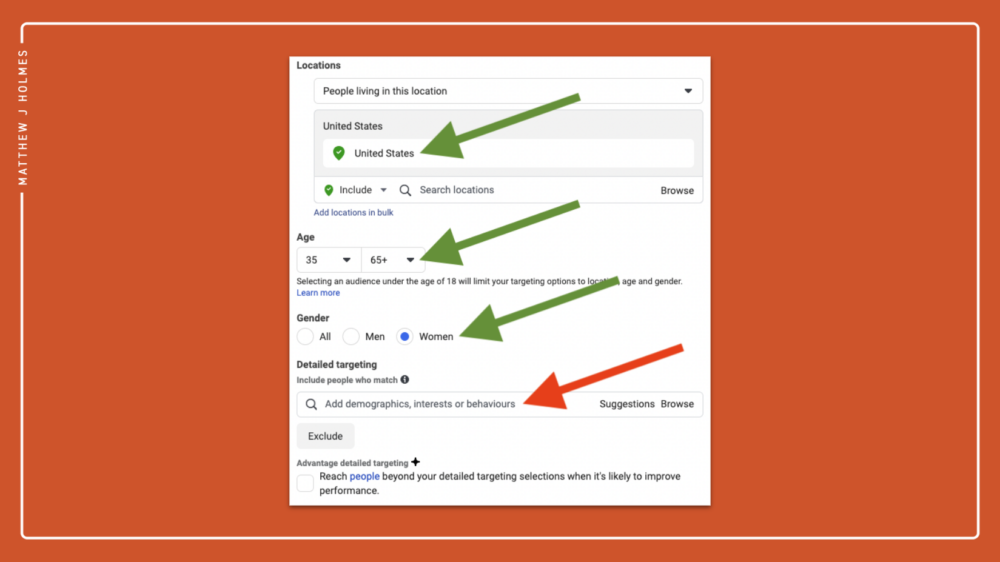
As you can see, I’m targeting:
Women, aged 35–65+, who live in the United States
The red arrow in the image above is demonstrating that I’m using zero Detailed Targeting. I use this targeting approach for every single Facebook Ad I run. The results, compared to Detailed Targeting:
- Doubled our Facebook Ads conversion rates in the USA
- Tripled our Facebook Ads conversion rates in the UK
- Cheaper costs
- More scalable
- More stable (less volatility)
- More profitable Facebook Ads (because I’m not spending money testing audiences)
The Facebook Ads algorithm loves account simplification because it can work freely, without being restricted everywhere it turns—which is the common scenario it faces with most advertisers. So, I have simplified my Facebook Ads Account Structure in a way that takes full advantage of Facebook’s incredible machine-learning and AI capabilities.
Here’s how it works:
- I use ONE Campaign per book, per country.
- All my testing and scaling is performed inside this one Campaign.
- Within this one Campaign, I have up to 3 active Ad Sets at any one time:
- 1 x Ad Set that contains my winning (proven) Ads
- 1–2 Ad Sets that are testing Ads for me (more on this coming up)
Ad Sets are where you define the targeting for your Facebook Ads, as well as where you want your Ads to show across Facebook’s (Meta’s—as this is now the parent company of Facebook, Instagram, WhatsApp, etc.) ecosystem.
The diagram below shows a visual representation of my account structure:
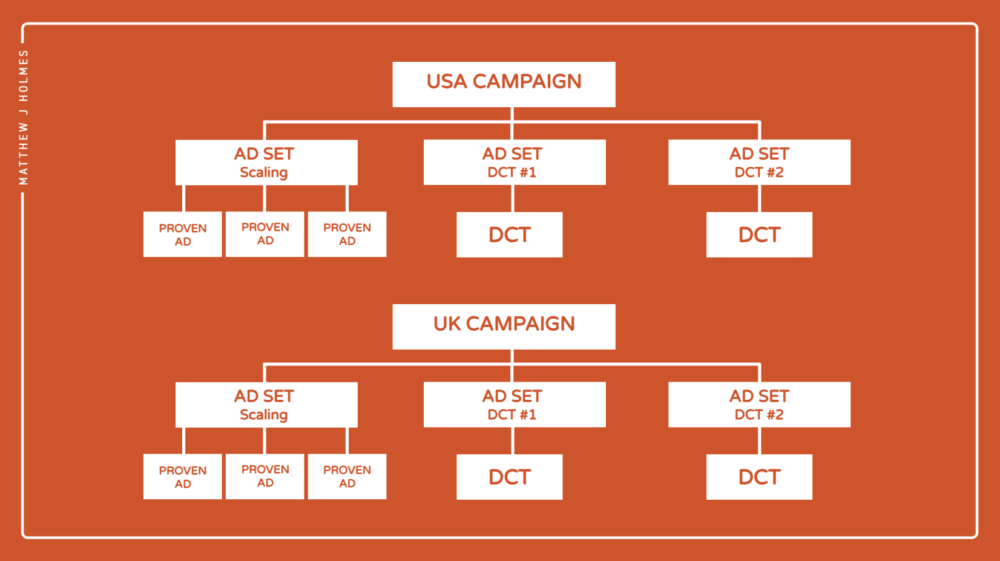
N.B. “DCT”, as shown in the diagram above will become clear very shortly!
Finally, I set my budget at the Campaign level, not the Ad Set level (another best practice I don’t follow). I do this using something called Advantage Campaign Budget.
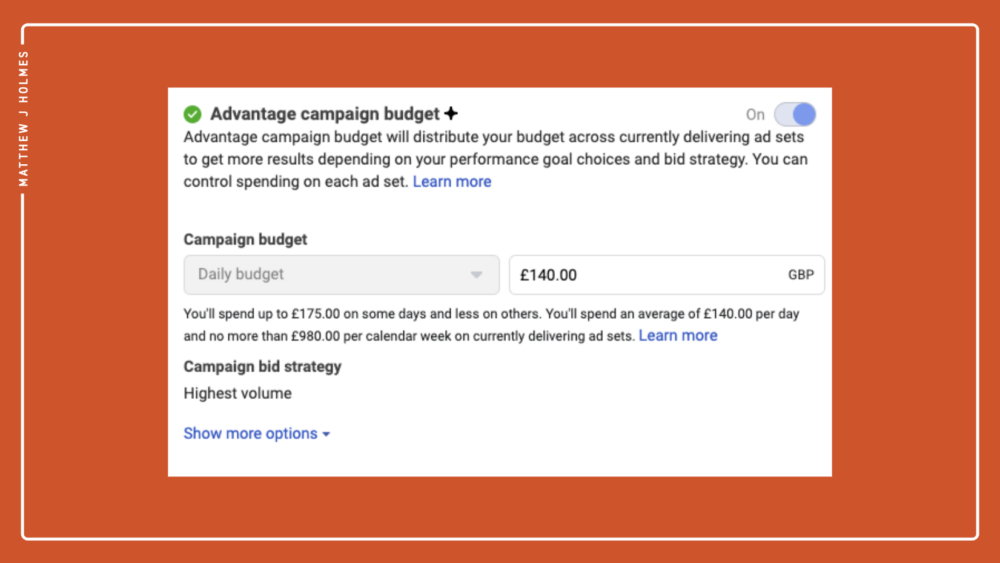
This setting will tell Facebook to spend the daily budget you determine (I’d recommend $20 per day at a minimum), on the Ad Sets that contain the ads driving the most engagement—and usually, these ads are the ones delivering most of the sales and/or page reads.
The result of this incredibly simple account structure means that you’ll spend far less time in your Facebook Ads account, allow the algorithm to work to its full potential, and produce more profitable results because you’re showing your ads to people who actually want to see them, and not wasting money testing Detailed Targeting audiences. And on top of all of that, this strategy is going to provide you with more time for writing!
If you’re feeling skeptical about putting so much trust and faith into the Facebook Ads algorithm, I completely understand, as I felt exactly the same when I first started dabbling with this strategy. It feels like it shouldn’t work, but it does. To the tune of $300+ per day in profitable, Facebook Ads spend for myself, with a 2x return on investment.
But it’s not just me this strategy works for, if that’s what you’re thinking. I have shared this exact strategy with countless authors inside my FREE Facebook Ads For Authors Masterclass video series, and I hear success stories multiple times per week.
With the strategy covered, let’s now move onto what is often considered an afterthought by many authors running Facebook Ads (myself included in the beginning), but is in fact the single biggest driving factor of your success.
The biggest Facebook Ads lever you can pull
The easiest thing to do with your Facebook Ads is to change the targeting—i.e. change who you are showing your ads to, using Detailed Targeting. As we’ve already discussed though, using Detailed Targeting is the same as investing in a financial stock or share that will forever tumble downwards.
A more difficult thing to do with your Facebook Ads is work on your skills as an advertiser, creating better and better ad creative—i.e. the ads people are seeing on their Facebook Feed. Focus on this, and your results will explode. Ignore it, and watch your Facebook Ads crash and burn.
Yes, creating better ads is hard, but with the advancement of AI tools such as Google Bard, ChatGPT and MidJourney, creating assets for your ads has in fact never been more simple. It’s not easy, but it is simple.
If your Facebook Ads aren’t working, best practice will tell you to show your ads to a different Detailed Targeting audience. I’m here to tell you that this is the wrong approach. Sure, the ads might work for a short amount of time, but after a few weeks, or months if you’re lucky, you’ll be back in the exact same position.
By committing to working on your craft as an advertiser, and creating better and better ads based on your research and analyzing the data of your own ads, in 3–6 months time you will be so far ahead of where you are today, you will surprise even yourself.
Personally, I have created and launched over 1,500 Facebook Ads for Book 1 of my wife’s fantasy fiction series. That’s a lot of ads. But if you compare the results of my first ads to my latest ads, the difference in quality, professionalism, performance and results is night and day.
If you want to improve your skills at anything in life, you need to commit to doing that thing regularly, analyzing the results, and iterating based on those results. This is partly why I test new Facebook Ads every single week.
The other reason I test Facebook Ads weekly is because I want to provide the Facebook Ads algorithm with plenty of assets and opportunities to find new readers day in, day out, and discover ads that perform well which I can scale up to reach a bigger and bigger audience.
Let’s now jump into my Facebook Ads testing process and I’ll explain how I test Facebook Ads so regularly and the strategy I use to do so.
How I test Facebook Ads (without doing any of the heavy lifting)
As I’ve already mentioned (on several occasions), the Facebook Ads algorithm is incredibly powerful and knows more about its user base than we can comprehend. Not only can we harness the power of the algorithm to find our ideal audience through unrestricted targeting, but we can also use it to test our Facebook Ads creative for us. By this, I mean the ads that people are seeing on their Facebook feed, Instagram feed, etc. The method of testing Facebook Ads creative I’m soon going to share with you is another cornerstone of my Facebook Ads strategy, that allows you, as the advertiser, to do much less of the heavy-lifting that is usually required.
The traditional way of testing Facebook Ads is to test ads individually, like this:

As you can see from the diagram above, there are multiple ads within a single Ad Set. This is how I used to test Facebook Ads too. The difficulty and challenge with this approach is that you are essentially forcing certain ads onto people who may not like what you’re showing them, which drives up costs and reduces performance.
Fortunately, there is a solution: it’s called Dynamic Creative. And here’s how the account structure looks when using Dynamic Creative:
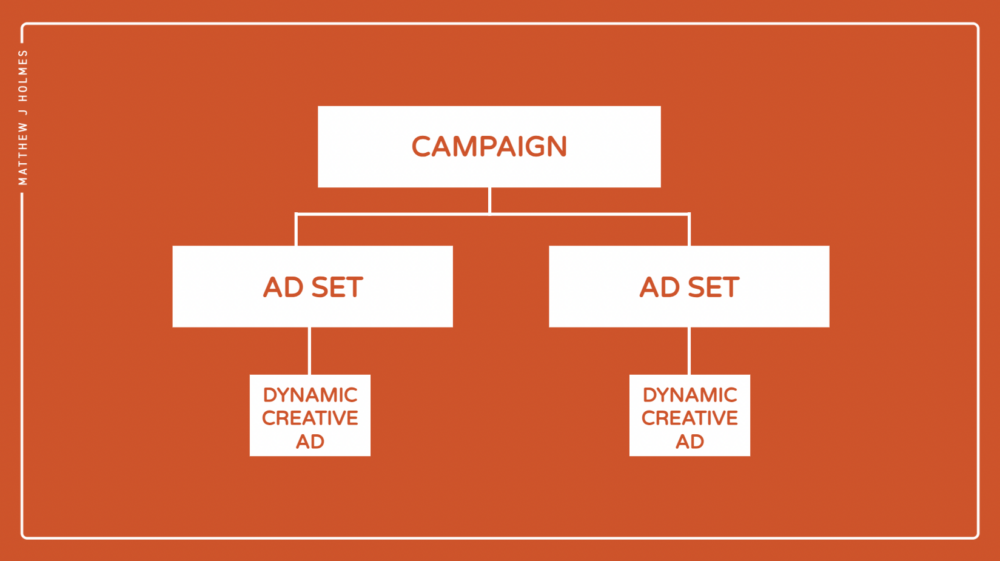
As the diagram above shows, with Dynamic Creative, you only have ONE ad within an Ad Set, keeping things much more streamlined and simple.
Here’s the beauty of this strategy though. Within this Dynamic Creative Ad, there are multiple assets:
- Multiple images
- Multiple headlines
- Multiple primary texts
- Multiple descriptions
- Multiple call-to-action buttons
What Facebook will do with Dynamic Creative, is test combinations of all the assets within the ad, and, after a few days, you will know the winning:
- Image
- Headline
- Primary text
- Description
- Call-to-action button
This results in far less guesswork from you, trying to figure out which are the best pieces of a Facebook Ad! You’re letting Facebook do all the testing on your behalf. Once you know what the winning assets are, after Facebook has tested them for you, you can then take those winners and create a “standard” ad (i.e. a Non-Dynamic Creative Ad), and scale it up, with the confidence behind you that every part of this Ad is proven to perform.
I call these Dynamic Creative Ads, DCTs, standing for Dynamic Creative Tests, and, as we covered earlier on in this article, they can be seen in my very simple, but very effective account structure.

So, if you’re not yet using Dynamic Creative, I would urge you to start. It has been an absolute game-changer for not only my own Facebook Ads but also the authors who I have shared this strategy with.
Let’s now move onto the final piece of the Facebook Ads puzzle: optimization and scaling.
Optimizing and scaling Facebook Ads by doing less, not more
Optimization and scaling may sound a little overwhelming, but they are in fact very simple, and we’ll cover what both of these are here. Optimization is simply doing less of what is working and more of what is working. That’s all it comes down to. You’re just making your Facebook Ads more efficient by allowing your budget to be spent on the ads that are working. Once you know how a Facebook Ad is performing (i.e. how many sales it’s generating), if it’s not up to scratch, you simply turn that ad off. This will allow your budget to be spent on ads that are working and converting at an acceptable conversion rate, rather than being “wasted” on ads that aren’t generating many or any sales for you.
If you’re using Facebook Ads to advertise your books that are listed on Amazon, you should 100% be using a free tool provided by Amazon, called Amazon Attribution, which allows you to see how many sales and page reads an individual Facebook Ad is generating for you. This is critical information to understand because, without it, you wouldn’t know which Ads were converting and which weren’t, making optimization very difficult.
I’ve recorded a free video on how to set up and use Amazon Attribution, which includes a full video walkthrough. Click here to watch the Amazon Attribution Setup Video.
I used to “optimize” my Facebook Ads on a daily basis. This was a big mistake, as I never allowed the algorithm to work its magic. I now block out 60–90 minutes per week (on a Monday afternoon) to optimize my Facebook Ads. That’s all it has to take. Over-optimizing your Facebook Ads is a thing, and it will destroy your results. Less is more.
When you’ve optimized your Facebook Ads, you can then think about scaling. Scaling Facebook Ads is also very simple and takes mere seconds.
With the strategy I have shown you in this article, as we are setting the budget at the Campaign level, using Advantage Campaign Budget, the only thing you need to do to scale your ads is increase the budget—which takes all of about 6 seconds! Providing you know your Facebook Ads are converting well, scaling will allow your ads to reach more people. And because you’ve optimized your Ads already, you know you’re putting more money behind Ads that have been proven to convert.
What I will say about scaling is that you shouldn’t go too hard, too soon. Be respectful of your budget and don’t go in too heavy-handed, as this will only halt the momentum and traction you’ve built up with your Facebook Ads.
Instead, what I recommend is that you increase your budget by 10%–20% per week, if you’re profitable. If you’re not profitable, either leave the budget as it is for another week, and let the optimizations you’ve done take effect. Or, drop the budget by 10%–20% and allow that to run for a week.
If you increased your budget from $20 to $100 per day in one hit, Facebook’s algorithm wouldn’t know what to do with such a huge budget increase, and it would likely find poor-quality people to show your ads to, just so it can spend your entire budget each day. By gradually scaling your budget up on a weekly basis, you’re allowing the algorithm the opportunity to learn who your ideal readers are and find more people like them to show your ads to.
Parting thoughts
You’re now equipped with the knowledge and understanding to start running Facebook Ads for your books in as little as 60–90 minutes per week, using a proven blueprint and strategy, leaving you more time for writing.
Before we wrap up here though, I want to share one big lesson with you that I’ve learned after spending hundreds of thousands of dollars on Facebook Ads.
Always look at the big picture
Looking at your Facebook Ads in isolation is a mistake I see many authors making. This is especially true when you are sending traffic from your Facebook Ads to your book(s) on Amazon.
Amazon has their own algorithm (that is perhaps even more difficult to fathom than Facebook’s algorithm!), and if you can show this algorithm that your books are selling well, Amazon will be more inclined to give your book more visibility. This enhanced visibility allows you to generate what are commonly known as organic sales. In short, organic sales are sales that are “free”, because you haven’t paid for them directly through ads. You will likely have seen your Best Sellers Rank on your book product pages on Amazon.

The lower the number of your Best Sellers Rank, the more visibility (and more marketing) Amazon will give you. Amazon may even start emailing their customers about your books.
To put this into perspective, with my wife’s books, only around 20% of our total sales come from our Facebook Ads. The remaining 80% are organic sales. But without the Facebook Ads driving those sales, our Best Sellers Rank wouldn’t be where it is and we wouldn’t be driving anywhere near that number of organic sales.
The other thing to keep in mind regarding the big picture is that you may only be advertising one book with your Facebook Ads, but if you have multiple books published, a good percentage of readers will go on to read those. And sales of these other books need to be accounted for. It’s not all about the book you’re advertising with Facebook Ads. It’s about all the other books that readers who bought Book 1 will buy over their lifetime.
On a final note…
Facebook Ads are not a magic bullet.
They are simply a cog in a machine. A very important cog, but a cog nonetheless. Facebook Ads are an amplification tool that you use to position your books in front of your ideal readers and drive traffic to those books. It’s your book itself and the book product page that has to sell your book.
So don’t neglect honing your craft as an author, because no amount of advertising is going to sell a poor-quality book. Your book sells your book.
Thank you so much for taking the time to read this article; I truly hope you found it of value and that you can start transforming both your Facebook Ads results and your career as an author.
Matt Holmes helps self-published authors build a thriving, sustainable, and profitable six-figure business, using Facebook Ads as the driving force for reaching new readers every single day. He writes a free newsletter read by thousands of authors, called The Saturday Self-Published Author, helping authors run profitable, scaleable Facebook Ads and sharing lessons from building and growing his wife’s six-figure author business.
You can learn more and sign up for FREE here – When you sign up, you’ll also receive a FREE 3-day video course – The Facebook Ads For Authors Masterclass.
He lives in the UK with his author wife, Lori, their boys, Jacob, Caleb, and Jonathan, and their dogs, Freya and Loki. Learn more at his website or follow him on Threads.

Many thanks for sharing your process. I have seen first-hand the degradation of my targeted ads over time. I am happy to have a different approach to try some experiments.
I clicked on the link for the FREE Facebook Ads For Authors Masterclass video series but there was nothing there but a link to your book and a link to a paid course. No videos. Disappointing.
I found the information on the regular desktop version of the page, but the content is different on mobile with no mention of the video series.
Apologies about this; I have now fixed that issue 🙂 Thank you for pointing this out to me.
I’m adding this question here from a Facebook reader. Matt, are you able to answer?
Honest question: how would you know 20% of sales are from FB and 80% are organic, as stated in the article? Amazon doesn’t break down the source of sales for KDP authors. But let’s assume the percent of buyers who do buy after clicking is 10%. (The average across all industries is about 9.2%.) With every click-through costing at least .50 (in my experience), every Amazon sale from FB will cost at least $5. To break even, you’d need to price your books at $6.99. The book in the link is $2.99. At $5 a successful click and buy, how is that profitable?
Good question. I can see how many sales and borrows come from the Facebook Ads (using Amazon Attribution), and because I’m not doing any other marketing or advertising, I know that all the other sales and borrows are organic. My CPCs are around £0.12 with Facebook Ads, and we pull in around $8,000 – $9,000 profit per month. Hope that helps 🙂
Are you also being charged with impression costs? (see my question above)
Thanks for the article. Question, the default for a Dynamic Ad is: Campaign Details (Auction and Traffic) with the performance goal set to maximum number of clicks. A setting can allow the user to select “When you get charged.” It defaults to impression, but can be changed to CPC. I’m curious if you change this setting? and why?
Hello Matt! Great stuff, thank you! I have two series of historical fiction (from other authors) and after 5 months of advertising on Facebook they are starting to be solidly profitable. Based on my experience, I’d like to make a comment and ask two questions:
comment: in the early stages (when we were spending $10-15 a day on FB ads) it lowered the cost of clicks to narrow the audience manually (without affecting conversion).
question 1: now that the campaign has run for 5 months and FB has gathered plenty of data, do you think moving to advantage+ by simply ticking off the box would do the trick? Or should I merely remove the restrictions? Should I make a change in the ad itself or duplicate it?
question 2: you’re spending about $8K on FB ads a month–call it $275 a day. How long did it take you to get to that level? I’m at $35 per series per day and everyone says to increase that just 10% a week. But that will take forever!
Thanks for such a great article! I am implementing your strategy now. I’m curious, however, on how I determine which assets are the most successful. I have a Dynamic Creative ad with two videos, two primary texts, multiple headlines, etc, allowing Facebook to show what it thinks best. Where do I find out which assets are working best?
In the Ad Manager under the ‘Breakdown’ tab (three horizontal bars) you can choose ‘dynamic creative element’ and see how each one is performing.
Thanks for this Matt. I’ve followed your videos too – the best guide to FB ads I’ve seen. There’s one issue I can’t work out. How does your campaign structure work with Facebook’s approach to overlapping audiences (ie. FB won’t let ads from one advertiser compete with themselves if they are targeting the same audience)? Doesn’t this mean that your DCTs won’t get properly tested as they all have the same audience?
Do you use Creative Dynamic and do you use link clicks or landing page as your desired outcome? Thank you for the information.